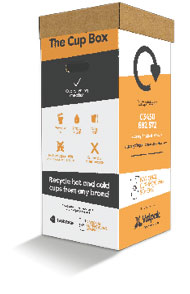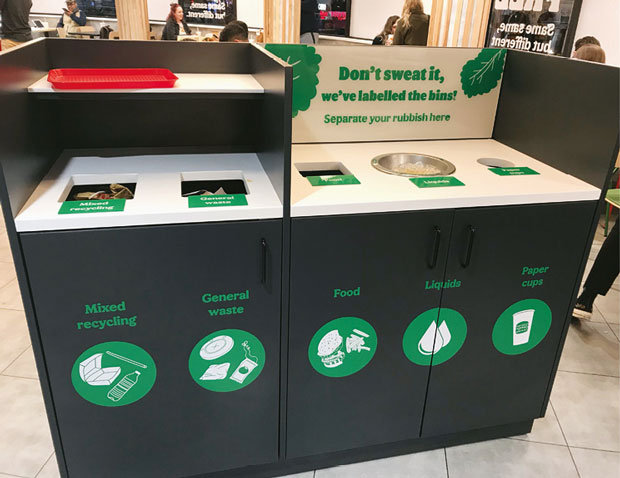New legislation for disposable cups calls for on-site collections and data reporting. Hannah Osman, Manager of the National Cup Recycling Scheme, explains what businesses need to do to prepare
Catering is a complex business. As well as purchasing, storing and preparing consumables, managers need to think about the customer experience, handle cleaning contracts and set up efficient waste management systems. From October 2025, when new legislation comes into force, on-site cafés will also need to think more carefully about the way they deal with disposable cups.
Under the new regulations, businesses with more than 10 staff FTE (full time employment), which sell filled, fibre-based beverage cups to staff or to customers will need to comply. As well as reporting twice a year on the volume of cups sold and the weight of cups sent for recycling, they will also be required to host take-back schemes on-site. Collections must be brand-neutral, and accept any cup, including those which have been purchased at other locations.
WHY DO WE NEED TO RECYCLE CUPS?
According to Valpak research* produced for WRAP (Waste and Resources Action Programme), half a million single-use coffee cups are thrown away in the UK every day. If we dispose of them properly, we can reduce carbon, as well as the volume of waste sent to landfill or energy recovery. Setting up a recycling collection also helps businesses to improve recycling rates and is a popular move with consumers.
ARE CUPS REALLY RECYCLABLE?
The good news is, yes! Single-use cups can be recycled up to seven times, and we already have the capacity to recycle every one of the 3.2 billion single-use cups generated in the UK.
HOW CAN CUP RECYCLING HELP BUSINESSES REACH NET ZERO?
Recycling reduces a cup’s carbon emissions by 50 per cent. To give an idea of scale, one NHS trust with three hospitals and over 5,000 staff can produce around 1,000 cups a day. In just a short time, the carbon impact of recycling can really stack up.
DATA
When the new legislation comes into force, organisations will need to report twice a year. This is an entirely new requirement, and businesses are more likely to  hold this information by number of cups than in the required tonnage format. In our work around packaging compliance, sourcing the correct weights is often one of the greatest challenges. Valpak regularly weighs products to provide producers with reliable data, and we advise obligated businesses to plan ahead.
hold this information by number of cups than in the required tonnage format. In our work around packaging compliance, sourcing the correct weights is often one of the greatest challenges. Valpak regularly weighs products to provide producers with reliable data, and we advise obligated businesses to plan ahead.
WHAT’S STOPPING US?
While the UK specialist paper mills have the capacity to recycle every paper cup sold the number of cups collected falls short. The new legislation aims to address this gap.
As the administrator of the National Cup Recycling Scheme, Valpak has already been approached by cafeterias and coffee shops looking for advice on how to get ahead by setting up a collection system, or asking for support with collection boxes or collating data. This year, we launched a dedicated collection box for cups that holds up to 500–1,000 cups and is replaced when full.
BOXES AND BINS
Although every café will have features like sinks, kettles and counters, the size and style of each site varies, so the size and style of boxes or bins needs to adapt too. In an airport, for example, security concerns mean that waste must be collected in clear bags, while an office might use a collection box. In a busy public area, a tube stack is often more suitable for initial collection, before cups are transferred to a larger box.
CONTAMINATION
Cups need to be collected as a separate waste stream, with all the liquids removed, so the system needs to incorporate a way to remove liquids – either via a sluice box or down a nearby sink. Although minor contamination is acceptable, collection bins and tubes in public areas tend to see higher levels of contamination.
To encourage participation and prevent contamination, education is crucial. The clearer we can make things, the more chance we have of waste being placed in the right bin. For Valpak’s own cup box take-back scheme, we advise on the best places to position bins and provide clear signage to make things easier.
CONSUMER COOPERATION
To incentivise members of the public and staff to return their cups for recycling, some outfits offer discounts similar to those offered for reusable cups. Valpak’s consumer research shows support for this. Interestingly, the majority of respondents (61.55 per cent) were also willing to pay a slightly higher price to fund the recycling of disposable cups – almost 96 per cent said they would use a high street recycling bin designed for disposable cups.
With consumer appetite for cup recycling on the rise, the legislation has arrived at just the right time. Although take-back and data reporting may represent a challenge, businesses have two years to prepare. Those that begin now will reap the rewards.
*More info https://bit.ly/477Qhxp





